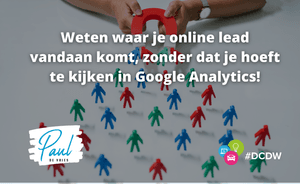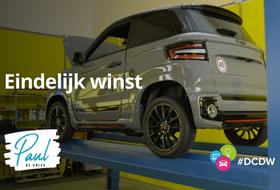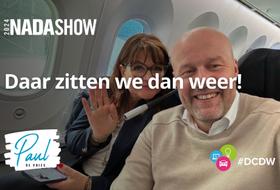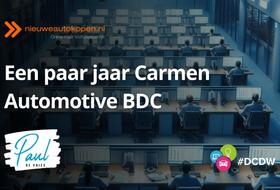
Knowing where your online lead comes from without having to check Google Analytics!
3 november 2023, PaulAs a marketer and sales director/manager, you’d like to know where your leads come from. Is it your own website, which is not a source but a destination? Of course, you also have leads from platforms like Marktplaats, Autotrack, Autoscout, and Viabovag, to name a few. While these sources are easy to trace, these portals also influence leads that eventually come through your website.
For instance, portals generate thousands of VDP views for the dealership’s inventory, without immediately resulting in a call or lead. These interested potential buyers may later search for your business on Google or click the link to your website, converting into a lead either immediately or later. So, how do you get an overview? At Ligier Store Doesburg and Experience Store Doesburg, I already have a good overview through Walcu CRM, especially with the ‘source buster’ code, which works well with LEF or Websolve, for example.
Source Buster is a free program that uses a code you essentially paste into your website’s dev. Similar to Google Analytics, which also uses a code/algorithm to obtain the same information, this code can determine where the converting visitor originates.
For example: a potential customer sees a Ligier on Marktplaats, views the car but doesn’t use Marktplaats’ Messaging Center or call. Instead, they click through to our website. There, they thoroughly inspect the Ligier but take no action. A week later, the potential buyer searches our website via Google, arriving via organic traffic, and converts there.
Now, most sales managers/directors might consider this a lead from their own website, and a marketer using Google Analytics may emphasize the importance of organic search traffic. However, we argue that Marktplaats created the opportunity. The same principle applies to any platform where VDP pages receive significant traffic, increasing the chances of conversion.
How does it look? How do I know? The lead comes into our Walcu CRM as an email, or via the lead-koppeling and has the following information.

In this first example, I receive a request through the own website, which is important, but it’s just a destination. Who ensured that this active buying customer came to us?
Here, you see that the first interaction came from Google through organic search traffic, but the visitor did not convert on the website. Later, the customer went to Gaspedaal, arriving back on our website through that channel and converting there, resulting in a lead that led to a sale. So, while I can say my website is the center of the universe, without good SEO foundation and recognition through a national channel, in this case, Gaspedaal, I wouldn’t have had the chance. I don’t need analytics for this; I see it directly in Walcu.
Another example:

Here, you see the power of Marktplaats as a national platform that exudes trust and serves as the starting point of the search. This customer eventually bought a Lynk and Co from us. The lead comes in on our own website: www.experiencestoredoesburg.nl. On October 2nd, the customer visits our website for the first time to have the opportunity to see the Lynk and Co in 360, for example. They don’t convert at that time, and the next day, they return to the Marktplaats ad, perhaps through favorites, clicking again on the link to the website. This time, they submit an inquiry that ultimately leads to a sale. However, in almost every management system in the Netherlands and Belgium, the source will be the own website, if it is even mentioned that this is an online sale! Indeed, what I often see is that it is reported as a “walk-in,” and the right ROI is never measured.
In our case, these are now listed as destinations: own website, campaign, gaspedaal, organic, and among the other Marktplaats listings.
So, below, you see two screenshots from Walcu of our store for a certain period:

Now you can also see that this live data on the website Ligierstoredoesburg.nl is very dominant. But that’s entirely normal! After all, 100% of my marketing efforts and investments online prominently indicate that we have a website and that you can go there for additional information. See, for example, investments in Marktplaats Pro, Google CPC, Facebook, and Gaspedaal. So, of course, most sales come from the own website! But now the question is, which campaigns are behind it?

Now you see that investments in “brand awareness” in general, combined with a solid SEO and GMB foundation, result in most sales. Brand awareness mainly comes back from the portals, which provide a cost-effective ROI on visited VDP pages.
After that, investments in Marktplaats listings, Marktplaats Pro, and Google CPC come to the fore, but even Autochat or Tiktok are made visible with Source Buster in such a way.
I understand that many entrepreneurs find investments in portals challenging, and it was even a reason for Bovag to start Viabovag. However, let’s be grateful that the big three, Marktplaats, Autoscout, and Autotrack, almost always have a positive ROI when looking purely at the data, and I don’t even count the direct leads. Thanks to these three, compared to abroad, we as car dealers still pay only a fraction of the real value they provide. And listen, I prefer to pay less too, but I simply rely on the data I have, and it tells the story for me.
Do you want to know more? Then sign up for our #DCDW Event on November 20 and 21 in Mechelen and Almere, where I will give a presentation on the available data in Automotive Marketing. You can register here:
Mechelen: https://www.dcdw.nl/dcdw-event-mechelen/




